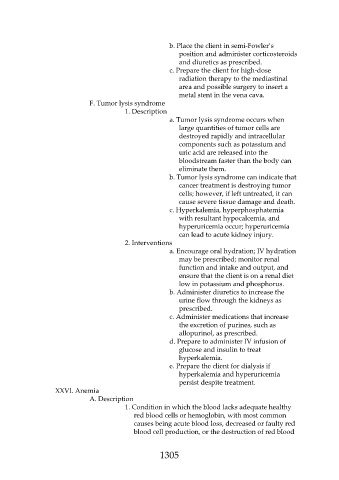Page 1305 - Saunders Comprehensive Review For NCLEX-RN
P. 1305
b. Place the client in semi-Fowler’s
position and administer corticosteroids
and diuretics as prescribed.
c. Prepare the client for high-dose
radiation therapy to the mediastinal
area and possible surgery to insert a
metal stent in the vena cava.
F. Tumor lysis syndrome
1. Description
a. Tumor lysis syndrome occurs when
large quantities of tumor cells are
destroyed rapidly and intracellular
components such as potassium and
uric acid are released into the
bloodstream faster than the body can
eliminate them.
b. Tumor lysis syndrome can indicate that
cancer treatment is destroying tumor
cells; however, if left untreated, it can
cause severe tissue damage and death.
c. Hyperkalemia, hyperphosphatemia
with resultant hypocalcemia, and
hyperuricemia occur; hyperuricemia
can lead to acute kidney injury.
2. Interventions
a. Encourage oral hydration; IV hydration
may be prescribed; monitor renal
function and intake and output, and
ensure that the client is on a renal diet
low in potassium and phosphorus.
b. Administer diuretics to increase the
urine flow through the kidneys as
prescribed.
c. Administer medications that increase
the excretion of purines, such as
allopurinol, as prescribed.
d. Prepare to administer IV infusion of
glucose and insulin to treat
hyperkalemia.
e. Prepare the client for dialysis if
hyperkalemia and hyperuricemia
persist despite treatment.
XXVI. Anemia
A. Description
1. Condition in which the blood lacks adequate healthy
red blood cells or hemoglobin, with most common
causes being acute blood loss, decreased or faulty red
blood cell production, or the destruction of red blood
1305

